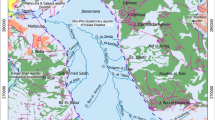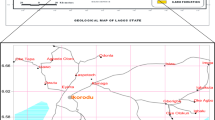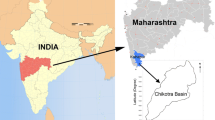Abstract
Geophysical logs provide a strong mechanism for interpretation and determination of the depositional environments, facies and also help in interpretations of hydrogeologic units. Spontaneous potential (SP) and resistivity logs can be used as an indicator of textural parameters. Pondicherry region has a complicated geology and with formation of different ages. The boreholes (BH) of this region are examined for litholog, SP and resistivity from four different BH locations, viz, Ariyankuppam, Chinnaverampattinam, Thavalakuppam and Nallavadu. These locations were studied and interpreted by using the shapes of the curves to identify the depositional environments, and this was later compared with the vertical litholog profile. Comparing the variation of these logs, the lateral variation of sedimentary facies was also attempted. The average resistivity values of Ariyankuppam, Chinnaverampattinam, Thavalakuppam and Nallavadu are 42.4, 30.4, 50.4 and 28.3 Ωm, respectively. Majority of the resistivity values corresponds from fine- to medium-grained sand, clayey pebbles, fine to very coarse sand and clayey sand with lignite. Frequency of resistivity values in each BH were identified for determining the dominant representative grain size. The study has pointed out the lithological variation of the system laterally and vertically using geophysical well logs.













Similar content being viewed by others
References
Alger RP (1968) Interpretation of electric logs in fresh water wells in unconsolidated formations. Schlumberger Well Surveying Corporation, Houston Texas
Ali SA (1977) Recognition of sand depositional environments from well logs. Gulf science and technology. HTSC Report 442A:10–33
Aly SA, El-sayed AM, el-Shawadfy A (2003) Application of well logs to assess the effect of clay minerals on the petrophysical parameters of lower cretaceous reservoirs north Sinai Egypt. Egypt Geophys Soc J 1(1):117–127
Asquith G, Krygowski (2004) Basic Well Log Analysis. American Association of Petroleum Geologist: 244
Baltosser RW, Lawrence HW (1970) Application of well logging techniques in metallic minerals mining. Geophysics 335(1):143–152
Bentley L, Gharibi M (2004) Two- and three-dimensional electrical resistivity imaging at a heterogeneous remediation site. Geophysics 69(3):674–680
Berg RR (1986) Reservoir sandstones. Prentice-hall Inc, Englewood Cliffs New Jersey, p 481
Blankennagel RK (1968) Geophysical logging and hydraulic testing. Pahute Mesa Nevada Test Site Groundw 6(4):24–31
Bridge JS, Smith ND, Trent F, Gabel SL, Bernstein P (1986) Sedimentology and morphology of a low-sinuosity river: Calamus river Nebraska sand hills. Sedimentology 33:851–870
Bryan L (1950) Application of electric logging to water well problems. Water Well J 4(1):3–7
CGWB (1993) Ground water resources and development prospects in Pondicherry region Union Territory of Pondicherry.
Chamley H (1989) Clay sedimentology. Springer, Berlin, p 623
Chidambaram S, Senthil Kumar G, Prasanna MV, John Peter A, Ramanthan AL, Srinivasamoorthy K (2009) A study on the hydrogeology and hydrogeochemistry of groundwater from different depths in a coastal aquifer Annamalai Nagar Tamilnadu India. Environ Geol 57:59–73
Coleman JM, Gagliano SM (1965) Sedimentary structures Mississippi River deltaic plain. In G.V. Middleton (Editor) Primary Sedimentary Structures and their Hydrodynamic Interpretation. SEPM Spec. Publication. 12: 133–148
Coleman JM, Prior DB (1981) Deltaic environments of deposition. In P.A. Scholle and D. Spearing (editors) sandstone depositional environments. AAPG Mem 3(1):139–178
Colquhoun DJ (1993) A new sea-level curve (Late Cretaceous to Present) north of the Georgia Trough, coastal plain and continental shelf, South Carolina and Georgia Geol Sot Am Prog Abstr A-466
Donald L, Siron L, Segall MP (1997) Influences of depositional environment and diagenesis on geophysical log response in the South Carolina Coastal Plain effects of sedimentary fabric and mineralogy. Sediment Geol 108:163–180
Dyck JH (1970) Some recent borehole logging applications in groundwater studies a review sask Res council Saskatoon. Sask Phys Div Rep 70–2:39
Edward Squires, Spencer H Wood (2001) Stratigraphic Studies of the boise (Idaho) Aquifer system using borehole Geophysical Logs with Emphasis on Facies Identification of Sand Aquifers.
Ekosse G (2001) Provenance of the kgwakgwe kaolin deposit southeastern Botswana and its possible utilisation. Appl Clay Sci 20:137–152
El-Shawadfy AE (2001) Integrated geophysical and geological study of onshore and offshore of North Sinai Egypt: M. Sc. Thesis Faculty of Science Ain Shams Univ:152.
Evans (1970) Lists 20 non-petroleum minerals including clay granter quartz coal and others which are amenable to borehole analysis.
Fagerlund F, Heinson G (2003) Detecting subsurface groundwater flow in fractured rock using self-potential (SP) methods. Environ Geol 43(7):782–794
Gala’n E (1986) Las arcillas como indicadores paleoclima’ticos: Boletı’n de la Sociedad Espanola de Mineralogı’a 9: 11–22
Galloway WE (1981) Depositional architecture of Cenozoic gulf coastal plain fluvial systems. SEPM Spec Publ 31:155
Galloway WE, Hobday DK (1983) Turigenous clastic d ∼ posilional sys/∼ms. Springer Verlag, New York
Galloway WE, Hobday DK (1996) Terrigenous clastic depositional system: applications to fossil fuel and groundwater resources. Springer, New York, p 487
Gendzill D (1964) Resistivity survey in the Last Mountain–Humbodt area Saskatchewan Sask Res Council Saskatoon Sask Phys. Div. Rep. p-64-I: 36.
Guyod H (1952) The single-point resistance method: electrical well logging fundamentals. The Well Instrument Developing C, Houston Texas, pp 13–17, also published in oil weekly114(12
Guyod H (1966) Interpretation of electric and gamma ray logs in water wells Well Log Analyst (January-March): 30–44.
Guyod H, Shane LE (1969) Geophysical well logging Hlbert Guyod Houston Texas: 256
Hillier S (1995) Erosion sedimentation and sedimentary origin of clays. In: Velde B (ed) Origin and mineralogy of clays. Clays environment. Springer, Berlin, pp 162–219
Hsieh B, Lewis C, Lin Z (2005) Lithology of aquifers from geophysical well logs and fussy logic analysis: Shui-Lin Area, Taiwan. Comput Geosci 31:263–275
Inman DL, Nordstrom CE (1971) On the tectonic and morphologic classification of coasts. J Geol 79:1–21
Jardani A, Dupont JP, Revil A (2006a) Self-potential signals associated with preferential groundwater flow pathways in sinkholes. J Geophys Res 111, B09204. doi:10.1029/2005JB004231
Jardani A, Revil A, Dupont JP (2006b) Self-potential tomography applied to the determination of cavities. Geophys Res Lett 33, L13401. doi:10.1029/ 2006GL026028
Jardani A, Revil A, Barrash W, Crespy A, Rizzo E, Straface S, Cardiff M, Malama B, Miller C, Johnson T (2009) Reconstruction of the water table from self-potential data: a Bayesian approach. Ground Water 47(2):213–227
Johnson HM (1962) Review article: a history of well logging. Geophysics 27(4):507–527
Jones PH Skibitzke HE (1956) Subsurface geophysical methods in groundwater hydrology in advances in geophysics 3. Academic, New York N.Y
Kwader T (1986) The use of geophysical logs for determining from spontaneous-potential electrical log curves. J Hydrol 43:41–47
Lau KC (2000) A review of downhole geophysical methods for ground investigation. Geotechnical Engineering Office Civil Engineering Department. The Government Of The Hong Kong Special Administrative Region. GEO REPORT No. 99
Lenin Kalyana Sundaram V, Dinesh G, Ravikumar G, Govindarajalu D (2008) Vulnerability assessment of seawater intrusion and effect of artificial recharge in Pondicherry coastal region using GIS. Indian J Sci Technol 1(7):1–7
Lin ZS, Hsieh BZ, Cai MY, Tang YD, Lee CC, Chen ST (1997) The hydrogeologic characteristics estimation of subsidence area in Yun-Lin Taiwan. Proceedings of the 2nd Meeting of the Groundwater Resources and Water Quality Protection, Tainan Taiwan, pp 853–864, In Chinese
Lin C, Gu L, Li G, Zhao Y, Jiang W (2004) Geology and formation mechanism of late Quaternary shallow biogenic gas reservoirs in the Hangzhou Bay area eastern China. AAPG 88(5):613–625
Linde N, Revil A, Bolève A, Dagès C, Castermant J, Suski B, Voltz M (2007) Estimation of the water table throughout a catchment using self-potential and piezometric data in a Bayesian framework. J Hydrol 334(1–2):88–98
Link MH, Osborne RH (1978) Lacustrine facies of the Pliocene Ridge Group California In Matter A and Tucker ME Modern and Ancient Lake Sediments special publication No2 International Association of sedimentologists: 169–187.
Loke M, Barker R (1996) Rapid least squares inversion of apparent resistivity pseudo-sections by a quasi-Newton method. Geophys Prospect 44:131–152
Lynch EJ (1962) Formation evaluation. Harper and Row, New York NY, p 421
Mandaokar BD and Debi Mukherjee (2012) Palynological Investigation Of Early Miocene Sediments Exposed At Panruti, Cuddalore District, Tamil Nadu, India Meher-Homji VM (1974). International Journal of Geology, Earth and Environmental Sciences ISSN: 2277–2081 (Online) An Online International Journal Available at http://wwwcibtech.org/jgee.htm. 2012 Vol. 2 (3) September - December, pp.157-175/Mandaokar and Mukherjee The natural history of Pondicherry and its environs. Review Historie de Pondicherry 12 45–54
Murray HH (1998) Kaolin minerals their genesis and occurrences. In: Bailey SW (ed) Hydrous phyllosilicates (exclusive of micas). reviews in mineralogy 19. Mineralogical Society of America, Washington D C, pp 67–89
Murray HH, Keller WD (1993) Kaolin kaolin and kaolin. In: Murray HH, Bundy W, Harvery C (eds) Kaolin genesis and utilisation. Special publication 1. Clay Minerals Society Boulder Co, USA, pp 1–24
Nair KM, Rao VP (1971) Result of shallow drilling in the area north of Pondicherry, unpublished ONGC field season report of 1969–1970
Nton ME, Esan TB (2010) Sequence stratigraphy of EMI field offshore eastern niger delta Nigeria. Eur J Sci Res Issn 1450–216x 44(1):115–132
Okiotor ME, Imasuen OI (2011) Facies characterisation of Well A Field Y North- Eastern Niger Delta. J Pet Technol Altern Fuels 2(4):45–54
Oteri AU (1988) Electric log interpretation for the evaluation of salt water intrusion in the eastern Niger delta. Hydrol Sci J Sci Hydrol 33:1–2
Parham WE (1966) Lateral variations of clay mineral assemblages in modern and ancient sediments. Proceeding International Clay Conference, Jerusalem, pp 135–145
Pattern EP, Bennett G (1963) Application of electric and radioactive well logging to groundwater hydrology: Geol. Survater supply pap: 1544-D
Paul Bauman (2005) A Primer Komex International Ltd. Calgary Alberta Canada 2-D Resistivity Surveying for Hydrocarbons April CSEG RECORDER 25.
Pethaperumal S, Chidambaram S, Prasanna MV, Verma VN, Balaji K, Ramesh R, Karmegam U, Paramaguru P (2008) A study on groundwater quality in the Pondicherry region. Eco-Chronicle 3(2):85–90
Pethaperumal S, Chidambaram S, Vijayaragavan K, Prasanna MV, Anandavel K, Karmegam U, Manivannan R, Anandhan P, Tirumalesh K (2010) A novel approach for groundwater budgeting using GIS in a part of Pondicherry region, India. J Water Resour Prot (JWARP) 2(6):585–591
Porrenga DH (1967) Clay minerals in recent sediments of the Niger delta. Clays Clay Miner 14:221–233
Radhakrishana I, Rao G (1990) Evaluation of hydrogeochemical parameters with Spontaneous potential logs. J Hydrol 114:245–257
Raghunath HK, Abraham J (2006) Formation Evaluation in Complex Lithology using NMR data. A Case Study of Western Onshore Basin India. GEOHORIZONS January 2006 /25.
Rao VP (1972) Field Party no 6 ONGC India.
Reineck HE, Singh I (1980) Depositional sedimentary environments with reference to terrigenous clastics second revised and update edition with 683 figures. Springer Verlag, Berlin Heidelberg New York
Revil A, Cary L, Fan Q, Finizola A, Trolard F (2005) Self-potential signals associated with preferential ground water flow pathways in a buried paleo-channel. Geophys Res Lett 32(7), L07401. doi:10.1029/2004GL022124
Rider M (1996) The geological interpretation of well logs Caithness, 2nd edn. Whittles publishing, UK, p 280
Robert C, Chamley H (1987) Cenozoic evolution of continental humidity and paleoenvironment deduced form the kaolinite content of oceanic sediments. Palaeogeogr Palaeoclimatol Palaeoecol 60:171–187
Robert C, Kennet JP (1994) Antarctic subtropical humid episode at the Paleocene–Eocene boundary: clay–mineral evidence. Geology 22:211–214
Robert C, Kennet JP (1997) Antarctic continental weathering changes during Eocene–Oligocene cryosphere expansion: clay mineral and oxygen isotope evidence. Geology 25:587–590
Royle AJ (2002) Exploitation of an oil field using AVO and post-stack rock property analysis methods. 72nd Ann Int Meet SEG Expanded Abstr 21:289–292
Schlumberger (1985) Sedimentary Environments from Wireline Logs Houston. 211
Selley RC (1978) Ancient sedimentary environments, 2nd edn. Chapman and Hall, London
Shemang E, Ekosse GE, Suh CE, Likkason OK, Maigari AS (2004) An evaluation of Paleocene kaolin deposits in northeastern Nigeria. N Jb Mineral 180(1):33–44
Singh M, Singh IB, Müller G (2007) Sediment characteristics and transportation dynamics of the Ganga river. Geomorphology 86:144–175
Suski B, Ladner F, Baron L, Vuataz FD, Philippossian F, Holliger K (2008) Detection and characterization of hydraulically active fractures in a carbonate aquifer: results from self-potential, temperature and fluid electrical conductivity logging in the Combioula hydrothermal system in the southwestern Swiss alps. Hydrogeol J 16(7):1319–1328
Tarek F, Shazly MA, Ramadan M (2011) Well logs application in determining the impact of mineral types and proportions on the reservoir performance of Bahariya formation of bassel-1x well western desert Egypt. J Am Sci 7(1):498–505
Temples TJ, Waddell MG (1996) Application of petroleum geophysical well logging and sampling techniques for evaluating aquifer characteristics. Ground Water 34(3):523–531
Thilagavathi R, Chidambaram S, Prasanna MV, Thivya C, Singaraja C (2012) A study on groundwater geochemistry and water quality in layered aquifers system of Pondicherry region southeast India. Appl Water Sci 2(4):253–269
Thilagavathi R, Thivya C Chidambaram S, Prasanna MV (2013) An Approach to study the hydrogeological and hydrogeochemical parameters using GIS. Geospatial Technology. Editors S.Vasudevan,G.Ramesh,T.Ramkumar, 199–208:ISBN 978-8186772-56-0.
Thiry M, Jacquin T (1993) Clay mineral distribution related to rift activity sea-level changes and paleoceanography in the cretaceous of Atlantic Ocean. Clay Minerals 28:61–84
Tixier MP, Alger RP (1970) Log evaluation of non-metallic minerals deposits. Geophysics 35(1):124–142
Vonhof JA (1966) Water quality determination from spontaneous—potential electric log curves. J Hydrol 4:341–347
Walker RG (1984) Shelf and shallow marine sands In WALKER R G (cd) Faciu Motkls Reprint &r Gt03cienu Can. 1.
Water resources and their management. Pondicherry region (1999).
White PA (1994) Electrode arrays for measuring groundwater flow direction and velocity. Geophysics 59:192–201
Williams AT, Caldwell NE (1988) Particle size and shape in pebble beach sedimentation. Mar Geol 82:199–215
Wilson BW, Nanz RH (1959) Sand conditions as indicated by the self-potential Log. EPR Memorandum report 51
Wishart DN, Slater LD, Gates AE (2008) Fracture anisotropy characterization in crystalline bedrock using field-scale azimuthal self potential gradient. J Hydrol 358(1–2):35–45
Wright LD, Coleman JM (1973) Variations in morphology of major river deltas as function of ocean wave and river discharge regimes. AAPG Bull 57:370–398
Yemane K, Kahr G, Kelts K (1996) Imprints of post-glacial climates and palaeogeography in the detrital clay mineral assemblages of an upper Permian fluviolacustrine Gondwana deposit from northern Malawi. Palaeogeogr Palaeoclimatol Palaeoecol 125:27–49
Acknowledgments
The authors wish to express thanks to the Ministry of Water Resources (MOWR) (file no. G11/1088/2011) for providing the necessary financial support to carry out this study, and author R. T. wish to express thanks to DST for providing the Inspire fellowship (DST/INSPIRE Fellowship/2010/[220] 18march,2011).
Author information
Authors and Affiliations
Corresponding author
Rights and permissions
About this article
Cite this article
Thilagavathi, R., Chidambaram, S., Prasanna, M.V. et al. A study on the interpretation of spontaneous potential and resistivity logs in layered aquifer sequence of Pondicherry Region, South India. Arab J Geosci 7, 3715–3729 (2014). https://doi.org/10.1007/s12517-013-1041-z
Received:
Accepted:
Published:
Issue Date:
DOI: https://doi.org/10.1007/s12517-013-1041-z




